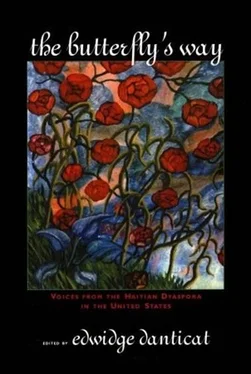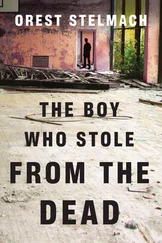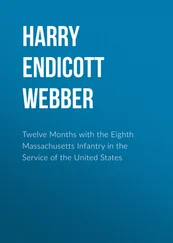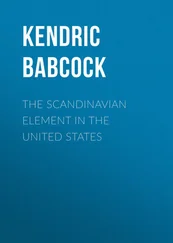Haiti is a woman with two sets of children.
I have always been told and have come to realize for myself that Haiti is like a woman with two sets of children, the elite and the masses. The elite are the children born to luxury, in wedlock, and the masses are the children born to poverty, the bastards. The elites abuse or completely neglect the masses. This reminds me of one of Pere's favorite sayings, "Se rat kay ki manje kay pay." It is the house rats who eat hay houses. I saw for myself, firsthand, the devouring of these hay houses in the summer of 1997, when I returned to Haiti with a group of students on a trip sponsored by the Ministry of Haitians Living Abroad. Our group was composed of students from France, the United States, and Haiti. This trip was intended to reacquaint people like me with the country that we had left at a young age and connect us with other students our age who were just finishing school in Haiti. While traveling in Haiti with the group, I got to see most of the country. The most startling sight I saw was the number of high-priced Landcruisers and Range Rovers traveling Haiti's roads. I couldn't believe that a country so poor could have people driving such expensive cars. The reason for those cars was revealed to me one rainy day when we were trekking in an old school bus from Port-au-Prince to the southern town of Cayes. I saw young children bathing in the muddy rainwater that had collected in the craters on the road. There were heaps of trash and debris all along the road. Whatever was in this collection of trash must have been decomposing because the smell was unbearable; yet the children washed their little angelic faces, arms, and legs in this sewage. On that day, I finally understood why the rich people need Land-cruisers in Haiti: to create craters for the poor to bathe in.
Before that month was over, I got to see Haiti's prosperous sons and daughters at work. We were invited to dinner at Kinam 2, Haiti's Ritz Carlton. The purpose of this assemblage was to network and connect with the rich and powerful so that we could one day return to "rebuild" the country. Over dinner conversations, the students in the group who were living in France and the United States got job offers from the Haitian company heads, but the students living in Haiti were completely neglected and certainly not offered jobs. At that moment, I understood Pere's saying about the cigarette burning at both ends and his saying about the house rat eating the hay house.
Pray to the I was on Saturday, pray to God on Sunday.
In his final letter, Antoine Thurel stated three reasons for which he died: family, country, and religion. Religion is one of the most confusing aspects of being Haitian. Haiti's primary religion is Vodou , yet we are even more confused about Vodou than the white man who while enslaving us told us it was evil. I once heard a prominent Haitian pastor in Boston say that slavery was God's way of reaching out and saving the African continent. The Haitian parishioners echoed their assent with undiscerning shouts and praises. How long will we continue to pay for this kind salvation? How many Antoine Thurels will die to purge us from it?
I have often imagined Pere and Antoine Thurel having a conversation. Pere would list his maxims expressing his disillusionment with our people and Antoine Thurel would list his dreams for our outward and inward liberation, the dreams that had motivated him to set himself on fire that morning on August 31, 1987. Perhaps they are having this conversation now in our ancestral African home in Ginen with Boukman, Toussaint, Christophe, and Dessalines; I wish I could hear that conversation. Perhaps I would get some answers to my questions, a few replies that would calm the tormented voices in my head, heal some of my continuing grief over Antoine Thurel's death. Still these questions, like Pere's final words, continue to haunt me. Why don't we see that the things we tell ourselves and our children become part of them, and part of us? When will we realize that all of Haiti's children belong to one family, the family of humanity? Why do we teach resignation in our churches? Why do we not respect our ancestors' words and legacy? Why don't we truly honor their sacrifices by treating ourselves and our poorer neighbors more humanely? Will we one day find the answers to those questions, or will we always remain a cigarette burning at both ends?
MY SUITCASES by Maude Heurtelou
When I was nineteen years old, I left Haiti for Guatemala City to enroll in a bachelor of sciences program. To prepare me for my trip, my parents fixed me two large suitcases filled with farewell gifts: from a bookmark made out of dry banana leaves to family photographs. What I didn't know then is that my suitcases were not only physical but also cultural. These suitcases, both cultural and physical, have been essential to my survival as an immigrant in three different countries.
Upon my arrival in Guatemala City, I whispered my aunt Didine's prayers to the saints, hummed Leon Dimanche's "Nostalgie" while longingly laying out and sifting through the items that had been lovingly packed in my suitcases: the talcum powder on my nightstand, which the vendor at the Iron Market in Port-au-Prince had wanted no payment for because I was leaving for university abroad. The multicolored kite that decorated my wall was made twenty years before by the neighborhood shoeshine man, who had presented it to my mother thinking she was carrying a boy. An unknown artist had sculpted the metal sheet lantern by my window. The small wicker basket in the corner of my room had carried dried Ilan Ilan flowers from my middle school in Port-au-Prince. The embroidered pillowcase where I rested my head each night was made by hand in the mountains of Jacmel. It was embossed with my great-grandmother's initials and passed down from my grandmother, to my mother, and now myself. My rubber sandals, a gift from my friend Marie, reminded me of traveling Haitian feet, steady, firm, and purposeful in their gait. I felt as though the ground beneath me was familiar whenever I wore my sandals. So many things in my suitcases comforted me, while reminding me of home.
Soon my classmates became curious about "la haitiana," the one who couldn't speak Spanish at first but was learning so fast. Little by little, I opened my suitcases, both cultural and physical, to them, sharing music, Haitian konpa , foods- griyo , plantains, rice and beans, pikliz -and stories of the feuding Haitian folktale characters Bouki and Malis. One day, I received a surprise visit from the national Guatemalan soccer team. The team was scheduled to compete against the Haitian national soccer team and wanted to look at me to get a sense of what Haitians would look like. Because I was taller than all the Guatemalan players, they assumed that all the Haitians would be very tall as well.
We were the only six Haitians reported to be in Guatemala City: a businessman, a female professor from the French Institute, and three other university students like myself. A few times a year, Claudette, the French professor, would invite me and the other three students to her home. During those afternoons at Claudette's, we would sit on her patio, eat Haitian food, listen to konpa music, and share stories from home. The oldest among us, Marijo, came from Jeremie, a southern Haitian town that had produced many famous poets. Marijo would recite verses that described the plush green landscape of the Haitian south. After her poetry recitals, Marijo would walk over to Claudette's piano and play the legendary Haitian ballads, "Haiti Cherie," and "Choucoune." One other student, Fadia, would dance while I told riddles.
Krik ?
Читать дальше












